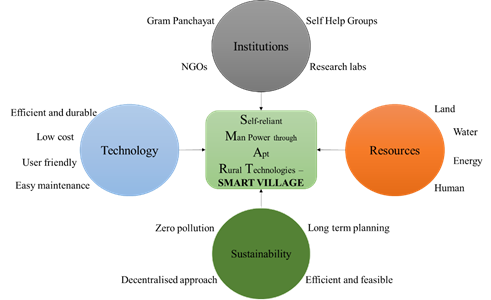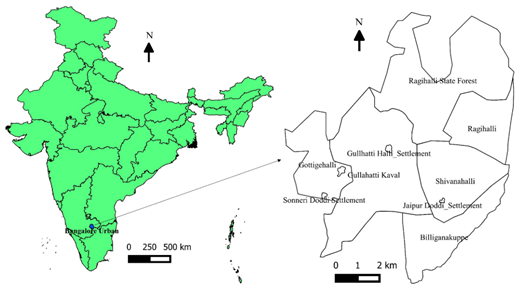| ENVIS Technical Report: 90, April 2015 |
1Energy and Wetlands Research Group, Centre for Ecological Sciences,
2Centre for Sustainable Technologies (astra)
3 Centre for infrastructure, Sustainable Transportation and Urban Planning [CiSTUP],
Indian Institute of Science, Bangalore, Karnataka, 560 012, India
Web: http://ces.iisc.ac.in/energy
E Mail: cestvr@ces.iisc.ac.in; ganesh@ces.iisc.ac.in
Tel: 91-080-22933099, 2293 3503 extn 101, 107, 114
4Adamya Chetana, Annapoorna - Bangalore, Community Hall,
Kempegowda Nagar, Bengaluru, Karnataka 560019
Tel: 080 2662 0404, E Mail: tejaswini.acf@gmail.com
5
R K Mission, Shivanahalli, Anekal, Bangalore,
E Mail: vishnumayananda@gmail.com
*Corresponding author: cestvr@ces.iisc.ac.in
|
|
|
Mahatma Gandhi envisioned the concept of an ideal village - a complete republic and independent of its neighbours for its vital daily needs. This is to ensure that every village grows enough food, milk and vegetables for villagers. It also has a school and nobody is refrained of basic education. Primary education is mandatory and schools have playground, proper sanitation and drinking water. Village has to maintain its own water resources ensuring clean water to all. As far as possible every activity in the village is conducted in cooperation basis without any discrimination. Smart village also refers to a bundle of services delivered to its residents through community participatory approach in an effective and efficient manner (Figure 1). The services include affordable clean water, basic education, shelter and food, communication and transportation, job for the youths, farms and grazing fields for cattle and a proper market for agriculture produce.

Figure 1: Framework of Smart Village
The Smart Village Framework for a region depends on the resource availability, people’s occupation, co-operation between the villagers and social acceptance. It is indeed important to understand the dynamics of socio-economic aspects of the village with geographical features and quantifying available resources. Knowledge of current skills and practices with gaps in the agriculture, energy, water resource and livestock management will help in choosing apt technologies for sustainable development.
Smart village framework essentially management approach based on the nature’s principles with sustainable technical interventions to achieve self-reliance in food, water, energy, education, job and other vital needs. The framework embraces local resources and skilled man power to ensure sustainable intervention of technology which are technically feasible, economically viable, user and environment friendly. Figure 2 gives the overall concept of a smart village framework for a self-reliant and self-sufficient village.

Figure 2: Smart village framework
The primary step is to quantify the available natural resources in the region which include land, water, energy and human resource. Status or the quality of the resource is also an important factor to be considered apart from quantity in order to implement technological interventions. However, educated and sensible human power is the most important resource as they constitute ultimate users and stakeholders of the all other natural wealth.
Technology is basically utilisation of resources to achieve required outcome such as agriculture and agro processing, livestock and milk products, oil seed cropping and oil extraction, medicinal plants and herb production etc. On the other hand, technology can also help to improve the resource status and balance the natural system. For example, percolation ponds and check dams across the streams will increase the water percolation and recharges the ground water. Planting grass like lemon grass (Cymbopogon citratus) and trees in slopes conserves soil and water. Technological interventions should be aptly chosen for optimum utilisation of resources and the sustainable development of region.
Sustainability is a qualitative as well as quantitative parameter which is tagged with every process. In a village scenario sustainability refers to the revitalising the resources with a feedback process ensuring a closed operating cycle. Ideally, any process which displaces resource to achieve an outcome, either help in generating the utilised resource or should have neutral effect of the environment. Nevertheless, most of the village processes bring resources back to the system either in a residual form with technological interventions. For illustration, soil fertility used for agriculture is recuperated from organic manure, where agriculture residue is used as livestock fodder. The feedback process has to be maintained to ensure sustenance of resources. Proposed smart village framework ensures the sustainable agriculture, livestock, horticulture, energy utilisation and water exploitation.
Local institutional support plays a major role in achieving sustainable development of any region. Gram panchayat plays a key role in the implementation of developmental activities and also to get the feedback of stakeholders. It also coordinates with external institutions and with the other village committees such as Self Help Group (SHG), Village Forest Committee (VFC) etc. Intra village organisations and NGOs help in motivating the villagers and also to spread awareness about new schemes and rights. Research organisations (both government and private) can also impact the rural environment through vocational trainings, scientific technological introduction, CSR initiatives etc.
Sansad Adarsh Gram Yojana (SAGY)
Sansad Adarsh Gram Yojana (SAGY) was initiated by Govt. of India (http://pmagyonline.in/) with the vision to make at least one Gram Panchayat as an “Ideal Panchayat (Adarsh Gram)” from each Member of Parliament (MP) constituency every year. Guidelines narrate possible interventions in the village (http://pib.nic.in/archieve/others/2014/oct/d2014101101.pdf) and also the government departments which are responsible developments. A Member of the Parliament needs to adopt a Gram Panchayat from his constituency and understand the needs of people, status of resources and develop a village development plan which is executed with the help of various administrative departments.
Ragihalli Gram panchayat of Bengaluru Urban district is adopted under SAGY programme by Shri Ananth Kumar, Member of Parliament, Bangalore South, Bangalore and Honourable union Minister for Chemicals and Fertilisers. The village is located about 32 km from Bengaluru city centre in Jigani Hobli, Anekal taluk of Bengaluru urban district in Karnataka. The Ragihalli panchayat shares a common boundary with Bannerghatta National park which was Ragihalli state forest before 1972. Figure 3 illustrates the geographical location and villages of Ragihalli panchayat.

Figure 3: Ragihalli panchayat, Anekal taluk, Bengaluru urban district
|
Dr. T.V. Ramachandra
Centre for Sustainable Technologies, Centre for infrastructure, Sustainable Transportation and Urban Planning (CiSTUP), Energy & Wetlands Research Group, Centre for Ecological Sciences, Indian Institute of Science, Bangalore – 560 012, INDIA.
E-mail : cestvr@ces.iisc.ac.in
Tel: 91-080-22933099/23600985,
Fax: 91-080-23601428/23600085
Web: http://ces.iisc.ac.in/energy
Ganesh HegdeEnergy & Wetlands Research Group, Centre for Ecological Sciences, Indian Institute of Science, Bangalore – 560 012, INDIA.
E-mail: ganesh@ces.iisc.ac.in
Subhash Chandran M.D.Energy & Wetlands Research Group, Centre for Ecological Sciences, Indian Institute of Science, Bangalore – 560 012, INDIA.
E-mail: mds@ces.iisc.ac.in
Tejaswini Ananth KumarAdamya Chetana, Annapoorna - Bangalore, Community Hall,
Kempegowda Nagar, Bengaluru, Karnataka 560019
E-mail: tejaswini.acf@gmail.com
Vishnumayananda SwamijiR K Mission, Shivanahalli, Anekal, Bangalore
E-mail: vishnumayananda@gmail.com
Citation:Ramachandra T V, Ganesh Hegde, Subash Chandran M D, Tejaswini Ananth Kumar and Vishnumayananda Swamiji, 2015., SMART Ragihalli: Effort towards Self-reliant & Self-sufficient system empowering Man power (rural youth) with Appropriate Rural Technologies,ETR 90, Energy & Wetlands Research Group, CES, Indian Institute of Science , Bangalore
| Contact Address : |
| |
Dr. T.V. Ramachandra
Energy & Wetlands Research Group,
Centre for Ecological Sciences, TE 15, New Biology Building, Third Floor, E Wing, [Near D Gate], Indian Institute of Science, Bangalore – 560 012, INDIA.
Tel : 91-80-22933099 / 22933503-extn 107
Fax : 91-80-23601428 / 23600085 / 23600683 [CES-TVR]
E-mail : cestvr@ces.iisc.ac.in, energy@ces.iisc.ac.in,
Web : http://wgbis.ces.iisc.ac.in/energy |
| |




